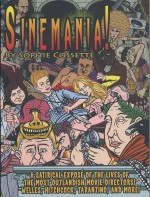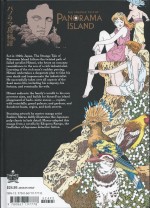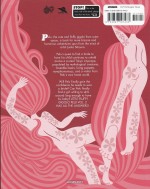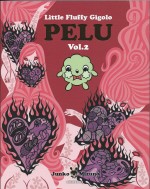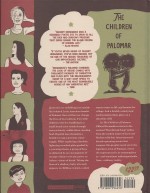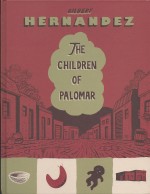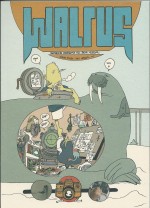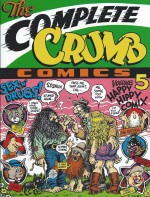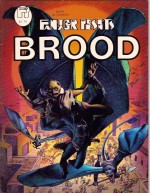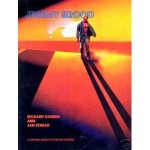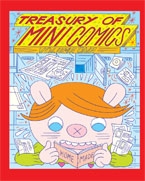
By many and various, edited by Michael Dowers (Fantagraphics Books)
ISBN: 978-1-60699-657-7
The act of stringing pictures and/or words together is something almost everybody has done at some stage of their lives. It’s a key step in the cognitive path of children and, for an increasing number of us, that compulsive, absorbing euphoria never goes away. Whilst many millions acquiesce to the crushing weight of a world which stifles the liberation of creation, turning makers into consumers, a privileged, determined few carry on: drawing, exploring, and in some cases, with technology’s help, producing and sharing.
Michael Dowers loves the concept of crafting and disseminating Mini Comics and his last book Newave!- The Underground Mini Comix of the 1980’s described and reproduced hundreds of examples: spotlighting with enticing, encouraging exuberance those driven artisans who came out of the “anything goes†1960s and 1970s Underground Commix movement still craving a vehicle of personal expression.
These creators aren’t in it for the money and, in the era before computers, they found enough time to write, draw and compile artwork (small press people are notoriously generous, contributing work at the drop of a hat) before laboriously photocopying, cutting, folding, stapling and then distributing the miniscule marvellous results.
Just by way of definition: most mini comics were home-produced pamphlets using borrowed – or when necessary paid for – print processes. The most popular format was an 8½ x 11inch sheet, folded twice, and printed at local copy-shops (or clandestinely churned out on school/work repro systems like early Xerox, Photostat, Mimeo or Spirit Banda machines) on letter – or any other sized – paper.
Because they weren’t big, they were called “mini commixâ€. Inspired, no?
Now this superb sequel tome – another massive brick of fun (8500 monochrome pages, 178x127mm) – offers another trip through forty years of free-thinking, self-determined free expression and technological developments. Many of the key figures in the creation and steady proliferation of this uniquely eloquent people’s medium are included here, not only through examples of their groundbreaking work, but also through statements, interviews and fond reminiscences.
Nobody who wanted to and had access to any kind of reproductive technology ever resisted making their own comics, and content comes from all over the North American continent, covering everything from superhero spoofs, monster-mashes, autobiography, recreational drug, religious, spiritual and philosophical diatribes and polemics, surreal experimental design and just plain fun stories, chatter and gags: all as sexually explicit, violent, political or personally intimate as their creators wanted them to be…
It all starts with Michael Dowers, himself the force behind not only this compilation but also Brownfieldpress and Starhead Comix, whose Introduction leads into ‘The Story of Quoz in Leonard Rifas’s Own Words’ after which the breakthrough Quoz #1 (1969) is reprinted in its quirky absurdist entirety.
Justin Green lays claim to having created the winning format of mini comics in his reprinted blog ‘Statement…’ before his groundbreaking Spare Comic? and inspirational Underground Cartooning Course (both from 1972) show us all how it should still be done…
Gary Arlington is highlighted firstly through an interview he gave to Comics Journal (#264) reporter Patrick Rosenkranz and his uplifting Awake! mini from 1972, followed by the delightfully morose adventure of Johnny Hangdog in Useless (1980) by Jim Siergey, and Larry Rippee’s comically macabre Skeletoons #18 from 1979.
Dowers’ interview of Richard Krauss (midnightfiction.com) is followed by the latter’s first self-publication Bar Fly Theater from 1979 and Bug Infested Comics: a 2008 collaboration with Bob Vojtko, after which Dickhead #1 by Clark Dissmeyer & Par Holman (1982) elaborates on the tricky life of a blue-collar talking penis…
Tales from the Inside was inmate Macedonio M. Garcia’s description of a convict’s existence, tellingly realised here in issues #1 and 3 from 1981 and 1982 (assisted by a script from inmate Melander), after which minor legend Matt Feazell of Not Available Comics describes his prolific career and re-presents The Amazing Cynicalman and Board of Superheroes #1 (1981 & 1994).
Another major player who crossed over into mainstream funnybooks was Matt Howarth whose beguiling The League of Mikes from 1983 took the lid off the collectors’ mentality and still rings true today, Steven L. Willis’ Brave New Nazis of the Inland Empire (1985) savages fascists with excoriating mirth, whilst Nukemare by Donald Russell Roach (1983) combines Cold War paranoia with glittery science fiction hope.
‘The Story of Outside In’ details an extensive collaborative effort which spanned 1983-2003 as a succession of editors and publishers shepherded an ambitious idea and made a little history.
As described in ‘Outside In Introduction‘ by Rick Bradford, Steve Willis conceived and produced issues #1-14 of a invitational mini which sought to print self-portraits by the movement’s many artisans (further described herein with a canny, funny strip of the book’s early days by Willis) before Dowers, Edd Vick & Hall Hargit and Bruce Chrislip recount their own tenures at the top.
A complete Outside In contributor list covering #1-50 follows, plus Hargitt’s primer Outside In-formation, before Brad W. Johnson’s Wurst Funnies (1986) returns us to strip sampling with a selection of sausage-inspired cartoon capers.
Dowers then interviews Tim Corrigan of C&T Graphics, after which Serious Comics #14 and 15 (1985) highlights the nigh legendary Mightyguy (a long-running minor success of the mid-1980s “Black & White Explosionâ€) and, from the same year, David Miller’s No More Bottled Milk! explores less commonplace comicbook themes…
Break out mini comics star Colin Upton reveals all to Dowers before his Self-Indulgent Comics #10 and 2008 Diabetes Funnies leads into Acid Man Society (1989) by Robert Pasternak, whilst Glenn & David Lee Ingersoll’s The Davey Thunder Jack Lightning Show: The Ugly Dog of Heaven is followed by Roberta Gregory’s Devolution.
A John Porcellino Interview is augmented by a selection of his short works spanning 1983-1993, comprising ‘I Wrote My Own Pink Slip!!’, ‘Smells Like Teen Bullshit’, ‘In der Nacht die welt dreht sich das Oberste zuunterst’ and ‘Night Time’, after which a heartfelt commemoration of the life, works and contribution of Dylan Williams (1970-2011) is delivered by Tom Spurgeon.
This tribute to mini comics’ “great synthesizerâ€, a major publishing force and founder of Puppy Toss and Sparkplug Comics, is followed by his own stunning Horse #1 and an assortment of other strips.
Eric Reynolds contributes Broken Picture Tube Theatre (1994), featuring ‘The Brady Lush’, ‘Barry Williams is Johnny Bravo‘ and other TV-triggered spoofs, whilst the bawdy Zelda Zonk’s Hyper Revue Folies Album (1993) comes courtesy of Quimby World Head Quarters and Molly Kiely, and is followed by the shockingly sordid Asphalt Aneurism #21 by Blair Wilson from 1994.
The mammary madness of Jim Blanchard’s Teat Warp #1 from the same year is counterpoised by 1995’s Moldy Fig (and other Sufi stories) by C. Cilla, whilst Jim Woodring & David Lasky’s sublime Jesus Delivers offers some sage advice to the overly zealous spiritual seekers to end this section.
Dowers’ Marc Bell Interview is followed by the beguiling sci-fi fable Arbeitees – Einer Industrium Dokument den Marc Bell ut Rupert Bottenberg (1996) and the documentary Yeast #6 by Ronald J.M. Regé Jr., before a Leela Corman Interview segues into her mordant 1997 Valentine and Karl Wills’ paean to childhood perversity Jessica of the Schoolyard in “Jessica’s Good Deedâ€.
Further of the period’s exemplars include Onsmith’s The Rouge Knuckle Gang, Cowboys Getting Racked by Travis Millard, the dark yet anthropomorphically lovely Kids These Days by M. Campos, Nate Beaty’s Mixtape (2006), I’m the Devil by Peter Thompson from 2007 and Fiona Smyth’s The Wilding from 2008…
The Carrie McNinch Interview by Dowers is backed up by her graphic journal You Don’t Get There From Here (#11, spanning December 15th 2008-March 23rd 2009) after which the Funchicken.com duo Mark Todd & Esther Pearl Watson are both interviewed, prior to his Bad Ass booklet and her Bike Repair Kit which portray the infinite variety of American person-hood. Then after fantastical Rudy, Vasilios Billy Mavreas’s Year in a Cone explores the graphic outer limits of imagination whilst No Exit by Andy Singer offers a humorous glimpse at Yankee obsessions such as sport, pets and the justice system…
#Noah van Scriver’s autobiographical Complaints (2010) descibes his own painfully restricted life and Sadist Science Teacher (Kelly Froh, 2010) continues in a similar journalistic vein, whilst the anonymous members of gimmeshelterpress reveal the build up of Bad Energy (2010), before Max Clotfelter’s Hole Show #1 and Marc Palm’s Hole Show #2 opt for a science fictional setting for their round-robin exercise in graphic collaboration to end the immense collected display of narrative virtuosity.
However this massive monochrome collection still holds a few more delights and, after the list of Artist Website Addresses, a full colour section reprints David Heatley’s Yesterday comic strip diary (from 5/11 to 6/10 2003), Night Terrors by Laura Wady, Fiona Smyth’s The Parkdale Gyre and a selection of equally enhanced full-hued covers by Krauss, Vojtko, Beaty & Rippee for Bug Infested Comics, Mixtape and Skeletoons.
The pioneering craftsmen who simultaneous started a self-printing movement and – now – tradition led inexorably to today’s thriving Alternative/Small Press publishing industry as well as the current internet comics phenomenon, and thus this book has incredible appeal on an historical basis.
However, that’s really not the point: the real draw of this compilation is that creativity is addictive, good work never pales or grows stale and the great stories and art here will make you keen to have a go too.
I’ve done it myself, for fun – even once or twice for actual profit – and it’s an incredible buzz (I should note that I am still married to a wife not only tolerant but far more skilled and speedy in the actual “photocopy, cut, fold, staple†bit of the process and willing, if not keen, to join in just so she might occasionally be with the compulsive dingbat she married…)
The sheer boundless enthusiasm and feelgood reward of making comics celebrated in this astoundingly vast, incredibly heavy and yet still pocket-sized hardback is a pure galvanic joy that will enchant and impel every fan of the art-form: as long as they’re big enough to hold a pencil, old enough to vote, and strong enough to lift this book.
Treasury of Mini Comics volume 1 © 2013 Michael Dowers and Fantagraphics Books. All contents © 2013 their respective creators or authors. All rights reserved.

